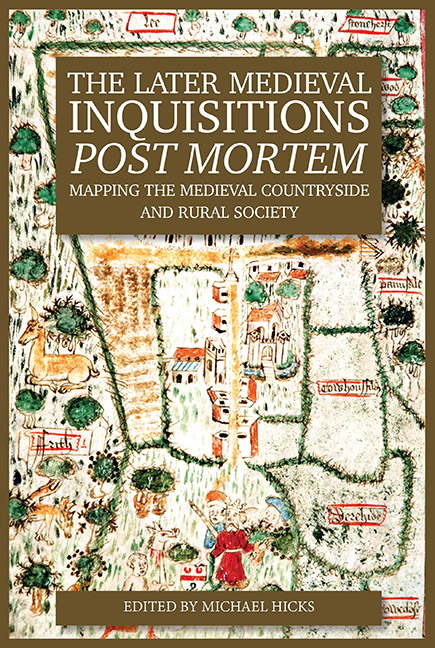Book contents
- Frontmatter
- Contents
- List of Illustrations
- List of Contributors
- Glossary
- List of Abbreviations
- 1 Introduction
- 2 Records of an Imperial Administration? Inquisitions Post Mortem in Scotland and Calais
- 3 Inquisitions Post Mortem in Medieval Ireland
- 4 The Court of the Honour of Clare, 1308–60: Feudal Incidents and Inquisitions
- 5 Landscape, Farming and Society in an English Region: The Inquisitions Post Mortem for the West Midlands, 1250–1509
- 6 Beyond the Dots: Mapping Meaning in the Later Medieval Landscape
- 7 Fairs and Markets in the Inquisitions Post Mortem
- 8 The Structure of the Milling Industry 1427–37
- 9 Proofs of Age 1246 to 1430: Their Nature, Veracity and Use as Sources
- 10 What Went On in the Medieval Parish Church, 1377–1447, with Particular Reference to Churching
- 11 Retainers, Monks and Wine: Three Insights into Everyday Life
- 12 The Administration and Efficiency of the Inquisitions Post Mortem Process: A Case Study of Northumberland
- 13 Late Medieval Land Disputes and the Manipulation of the Inquisitions Post Mortem
- Index
9 - Proofs of Age 1246 to 1430: Their Nature, Veracity and Use as Sources
Published online by Cambridge University Press: 26 May 2021
- Frontmatter
- Contents
- List of Illustrations
- List of Contributors
- Glossary
- List of Abbreviations
- 1 Introduction
- 2 Records of an Imperial Administration? Inquisitions Post Mortem in Scotland and Calais
- 3 Inquisitions Post Mortem in Medieval Ireland
- 4 The Court of the Honour of Clare, 1308–60: Feudal Incidents and Inquisitions
- 5 Landscape, Farming and Society in an English Region: The Inquisitions Post Mortem for the West Midlands, 1250–1509
- 6 Beyond the Dots: Mapping Meaning in the Later Medieval Landscape
- 7 Fairs and Markets in the Inquisitions Post Mortem
- 8 The Structure of the Milling Industry 1427–37
- 9 Proofs of Age 1246 to 1430: Their Nature, Veracity and Use as Sources
- 10 What Went On in the Medieval Parish Church, 1377–1447, with Particular Reference to Churching
- 11 Retainers, Monks and Wine: Three Insights into Everyday Life
- 12 The Administration and Efficiency of the Inquisitions Post Mortem Process: A Case Study of Northumberland
- 13 Late Medieval Land Disputes and the Manipulation of the Inquisitions Post Mortem
- Index
Summary
Records of proof-of-age hearings exist from the second half of the thirteenth until the mid-sixteenth century. The hearings were an addition to existing inquisition post mortem arrangements for tenants-in-chief of the crown, the purpose of the procedure being for the tenant-in-chief to ‘prove’ by means of the sworn testimony of a local jury that he or she was of age and so could enter their inheritance. A key and unique feature of a proof was the requirement for each juror to give a brief account of how he knew the heir's age. In doing so, jurors linked the heir's birth with details of their own personal lives, such as a birth, death or marriage in their family, their presence at the baptism or a reference to some dated document. Historians have long recognised their potential value, containing as they do personal details of the experiences of comparatively humble men whose lives are barely recorded elsewhere. They began to be calendared along with inquisitions post mortem at the end of the nineteenth century.
It is easy to see why historians recognised the usefulness of the calendared proofs, but a problem about using them was identified almost as soon as the first volumes of the Calendar were published. As early as 1907, for example, R.C. Fowler pointed out similarities in the sworn statements of witnesses in three proofs from the 1420s. In the same year M.T. Martin pushed back the period when such practice could be detected to 1328. A string of subsequent reviews drew attention to innumerable ‘correspondences’ within and between proofs as they appeared in the published volumes. By implication it was assumed that such plagiarism would, if detected widely, undermine the usefulness of proofs as sources. Continuing hesitancy over their veracity seems to have been a factor in most subsequent discussions.
I
The development of modern electronic databases has made possible the systematic analysis of a whole body of texts over a long period of time, rather than confining comment to ad hoc remarks on single volumes. In this case such a database enabled the wording of all 10,036 jurors’ proof testimonies from 1246 to 1430 to be compared, patterns of ‘correspondence’ between testimonies to be analysed and changes in vocabulary and syntax to be examined.
- Type
- Chapter
- Information
- The Later Medieval Inquisitions Post MortemMapping the Medieval Countryside and Rural Society, pp. 136 - 160Publisher: Boydell & BrewerPrint publication year: 2016
- 1
- Cited by

